Conceptually, Anti Dive is not really a difficult geometric program to understand. Engineers find a way to over-complicate what is simple. Hey, we need engineers, but our chassis builders build in only so much adjustment for Anti Dive so we really can’t get in too much trouble if we have a basic understanding of the mechanics involved. On a stock car, that has upper A-Arms and lower control arms (like the cars that you see in this magazine), it pays to simplify Anti Dive to the point of practicality. On a stock car, we can only take the adjustment to certain limitations so we can focus within the relative boundaries that a typical stock car situation presents.
Your car brand of car has the Anti Dive pre-set to match the philosophy of your chassis builder Still, all car builders give you a multitude of adjustments. With care, adjusting Anti Dive can be the fine tuning tool that helps you overcome a chassis problem, which in turn starts a positive domino effect that results in more speed.
Before you start playing around with Anti Dive as an adjustment, it does help if you know what it is? Randomly moving things falls in the luck category. While random adjustments are less than desirable, over thinking is equally as dangerous. Your car is built with limitations so the Anti Dive adjustments that fall in the practical category are pretty easy. Unless you get out a cutting torch – you can adjust way as if you are moving the panhard bar up and down. Just do it – and then undo it if the driver doesn’t like it. Keep it simple certainly applies.
So just what is Anti Dive? From the side view of your front suspension you have pivot points for the upper A-Arm and pivot points for the lower control arm. These pivots and their relative location to each other create Anti Dive. Anti Dive can be different on the LF and the RF. Manipulating Anti Dive differential at the LF and RF can be an adjustment that you can use to your advantage. Anti Dive is the common term, but we can use Pro Dive as part of the adjustment option set?
To visualize, have a look at your right front suspension. In general, the upper A-Arm pivots are parallel to the frame. If you look at the connection points at the bottom and visualize those as parallel to the frame you have zero Anti Dive. Now, maintain the visual of the bottom pivots being parallel to the frame – then move the back of the RF Arm down 1/2”. You just put Anti Dive in the Car. In this example, if you were to lower the front of the RF A-Arm pivot, from parallel, you would put Pro-Dive into the suspension. The same holds true on the Left side.
Create a an A-Arm arrangement that is identified as Anti Dive
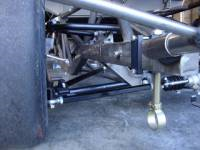 In this photo you can see that the RF A-Arm is nearly parallel to the frame. If you look at the lower pivot points they are parallel as well. Raising the front of the RF A-Arm, so that the front pivot is higher off the frame (ground) than the rear pivot, creates a an A-Arm arrangement that is identified as Anti Dive.
In this photo you can see that the RF A-Arm is nearly parallel to the frame. If you look at the lower pivot points they are parallel as well. Raising the front of the RF A-Arm, so that the front pivot is higher off the frame (ground) than the rear pivot, creates a an A-Arm arrangement that is identified as Anti Dive.
So, lowering the back of your A-Arms puts Anti Dive in the car – it’s an easy adjustment that you can make right at the track. You can adjust Anti Dive with the lower control arms, but for this article we are focusing on the upper A-Arms so that the concept is the focus. Hopefully, concentrating on the upper A-Arms reduces confusion in our quest to promote a new possibility. The goal is to get you to think out the information so you can see if you want to add adjusting the Anti dive to your adjustment arsenal this week.
Zero Percent Anti Dive
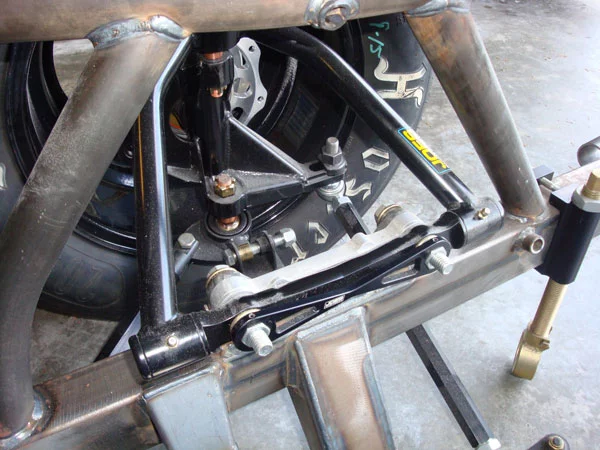 This view again shows the A-Arm parallel to the frame, which creates zero percent Anti Dive. you can adjust the Anti Dive with the lower pivots, but for this article we are focusing on the Upper A-Arms so that proving the concept is the focus. The concept is simple, but by taking the lower points out of the equation, for now, confusion is reduced and your understanding of Anti Dive will allow you to understand the adjustment. Once the engineering is understood – you will find that using the lowers to adjust Anti Dive has a dramatic affect and a little goes a long way. The Billet Nut Plate is a cool option that keeps your hands away from hot headers.
This view again shows the A-Arm parallel to the frame, which creates zero percent Anti Dive. you can adjust the Anti Dive with the lower pivots, but for this article we are focusing on the Upper A-Arms so that proving the concept is the focus. The concept is simple, but by taking the lower points out of the equation, for now, confusion is reduced and your understanding of Anti Dive will allow you to understand the adjustment. Once the engineering is understood – you will find that using the lowers to adjust Anti Dive has a dramatic affect and a little goes a long way. The Billet Nut Plate is a cool option that keeps your hands away from hot headers.
If the Upper pivots are parallel to the frame and the lower pivots are parallel to the frame then you have zero percent Anti Dive. You can adjust until you have 100% Anti dive and when the brakes are applied the front end will effectively be locked up and the suspension will not drop at all. The Anti Dive will carry the weight of the car based on the transfer from the rear coupled with the weight transfer affiliation of the Center of Gravity of the car – so there is the science. How about we just slap in some slugs and remove the complicated engineering speak?
Using A-Arm frame mounts with slots allows for the use of slugs making track side adjustments quick and easy. Slugs allow you to make adjustments in 1/8” (or smaller) increments and the solid mount ensures you can repeat adjustments with easy documentation. You can make a change and if the driver likes it then great – if not, a quick slug replacement gets you right back to your baseline. You can save the heavy math and engineering for when you have graph paper and a lot of time at the shop. At the track – simply slap in a slug to make a 1/8” to 1/2” adjustment at the upper A-Arm pivot and you have plenty of adjustment for Anti Dive or Pro Dive right at the track. You can make the change in 5 minutes and the slug system gives you hardware that is recordable and repeatable. Good science always comes with repeatability.
Slugs give you a solid mounting system that is secure and recordable
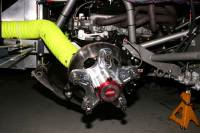 If you look closely, you will see a slug at the rear pivot of the Upper A-arm. The slug raises the back of the A-Arm as the offset is larger than the front. The slug combination raises the back of the A-Arm and this angle creates Pro Dive. A simple slug adjustment allows you to quickly change the amount of Pro or Anti Dive right at the track. Typically, slugs are made in 1/8″ increments so you can run Pro Dive as shown in the photo to help set your car into the turns. The slugs give you a solid mounting system that is secure and recordable.
If you look closely, you will see a slug at the rear pivot of the Upper A-arm. The slug raises the back of the A-Arm as the offset is larger than the front. The slug combination raises the back of the A-Arm and this angle creates Pro Dive. A simple slug adjustment allows you to quickly change the amount of Pro or Anti Dive right at the track. Typically, slugs are made in 1/8″ increments so you can run Pro Dive as shown in the photo to help set your car into the turns. The slugs give you a solid mounting system that is secure and recordable.
Now that you see how easy it is to move the A-Arm mounting slug hardware – why should you run Anti Dive? Or, why run Pro Dive? When it comes to racecar suspensions, everything is about timing. Anti Dive is creates mechanical resistance under braking. The percentage of Anti Dive can be drawn out on paper easily in the shop – at the track just toss in the different slugs to accomplish your goals. Under braking, Anti Dive resists the dropping movement at the front end under braking. With the mechanical resistance created by running Anti Dive, you can potentially run softer springs and the Anti Dive will carry you through the braking zone. When you get to the middle and lift off the brakes, the soft springs can allow the car to roll or drop as Anti-Dive is reduced to nearly zero when you are not loading the suspension with brake torque. Remember, the Anti Dive resistance occurs under braking so a bumpy track can potentially cause trouble – Anti Dive works best on smooth tracks. Well, I think it works best on smooth tracks and you will find that crew chiefs have varying opinions on this issue.
To help with the mental picture – if you have your RF A-Arm parallel to the frame, then the A-Arm is free to move up and down without any friction or mechanical resistance. If you were to exaggerate the adjustment and place the A-Arm so that the pivots were 90 degrees to the frame, instead of parallel, then you can see the suspension would be locked and could not move. Since practicality only lets us move the A-Arm pivot about a ½” up or down, in comparison to the other mounting hole on your A-Arm, you can see that the braking force resists movement based on the amount of adjustment that your slotted A-Arm ear allows for. Again, you can get more adjustment on the bottom if you need it, but we are focused on the top for simplicity of proving the concept.
Running a slotted A-Arm frame ear
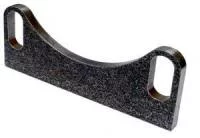 Running a slotted A-Arm frame ear on your car allows you to use pre-measured slugs that mate perfectly for a secure mounting system. Slugs that are engraved with the offset give you an easy reference so your team can record Anti Dive or Pro Dive adjustments in your set up book. Half inch slugs installed in the front of the ear and at the back of the ear give you a full inch of adjustment in a 6″ space. For most purposes, the percentage of Anti Dive achieved with the use of (2) opposing 1/2″ slugs is a large adjustment. With Anti Dive – a little goes a long way.
Running a slotted A-Arm frame ear on your car allows you to use pre-measured slugs that mate perfectly for a secure mounting system. Slugs that are engraved with the offset give you an easy reference so your team can record Anti Dive or Pro Dive adjustments in your set up book. Half inch slugs installed in the front of the ear and at the back of the ear give you a full inch of adjustment in a 6″ space. For most purposes, the percentage of Anti Dive achieved with the use of (2) opposing 1/2″ slugs is a large adjustment. With Anti Dive – a little goes a long way.
By now, hopefully you have an idea of Anti Dive, but what about Pro Dive? When would you want Pro Dive? If Anti Dive resists the nose dropping under braking then Pro Dive (when the front of the A-Arm pivot is lower than the rear of the A-Arm pivot) helps the nose to drop under braking. On a street car, Anti Dive is put in the right and left side to create braking stability. The same amount is run on both sides.
For racing, running Pro-Dive on the LF with Anti-Dive on the RF can help pull the car into the turn. In effect, the car gets some automatic steering under braking promoting a good set at corner entry. You can experiment with running Anti Dive on both sides, or running Anti Dive on the RF and a bit of Pro Dive on the LF. Simple slug changes allow you to see what works best at your track and with your driver.
Allowing for the ultimate in adjustment and repeatability
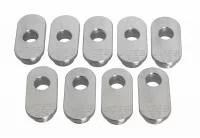 Slugs that mate with A-Arm ears are marked allowing for the ultimate in adjustment and repeatability. Simply record the slug numbers and your set up book will contain an easy reference to repeat adjustments.
Slugs that mate with A-Arm ears are marked allowing for the ultimate in adjustment and repeatability. Simply record the slug numbers and your set up book will contain an easy reference to repeat adjustments.
Considerations that come into play are the amount of braking force – if the track calls for heavy braking then the Anti Dive or Pro Dive is going to be accentuated by the full on brake force. If the track allows for smooth braking then maybe you can run more Anti Dive to accomplish your goal. In general, Anti Dive can help give the car stability at corner entry under braking – when the brakes are released your soft springs can ride over the bumps and roll easily into the turn. Running Anti Dive might allow you to run the soft springs that help in the middle or over bumps as the mechanical resistance created by Anti Dive carries you over the braking portion of the track.
Pro Dive on the LF might help set you into the turn – maybe you will be able to run a little less stagger by using a small amount of Pro Dive at the LF. Potentially, less stagger will keep your car hook up on corner exit? The trick is to mix the amount of Pro Dive on the LF with Anti Dive on the RF to help you overcome a problem without changing a spring that could hurt the car later in the turn. Maybe, the Pro-Dive in this scenario starts the dominos in the right direction allowing you to run less stagger?
Measure Anti Dive
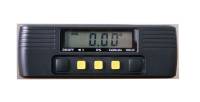 You can also measure Anti Dive by using an accurate level to record the A-Arm angle in degrees. An accurate Digital Level will give you a number that you can record in seconds.
You can also measure Anti Dive by using an accurate level to record the A-Arm angle in degrees. An accurate Digital Level will give you a number that you can record in seconds.
The same holds true for bite, stagger and all of the adjustments at your disposal. If you think out the when and where, Anti Dive can help you to fix a spot in the corner that is giving you trouble you can potentially use Anti Dive or Pro Dive to your advantage. While running Anti Dive is common place, Pro Dive can be a good place to experiment. It is standard to run Anti Dive on both front corners. It is very common to run Anti Dive on the RF with Pro Dive on the LF. All that said – there is no rule that says that Pro-Dive can’t be bolted into both front corners – just be careful that the car is stable under braking. All of my articles hammer on the concept that a car that is unstable at corner entry must be fixed or it is going to be a long night. I never risk a set up that has any possibility of being loose on corner entry – period.
By realizing that Anti-Dive resists movement under braking, and Pro-Dive promotes movement under braking, your team can overcome obstacles with another adjustment mechanism in your chassis set up tool box. Small changes go a long way. Using slugs allows you to make changes 1/8” at a time. 1/8” may not sound like much, but it is 1/8” on a 6” bolt pattern so the degree change is significant. Using a 1/2” slug turned up on the front of the RF A-Arm and a 1/2” slug turned down on the back of the RF A-Arm provides you with a ton of degrees of adjustment. I just write down the slugs dimensions – you can measure degrees with a digital level in about 3 seconds – keeping the article understandable is my goal.
The limitation is not in the hardware, but rather in your need to truly need Anti Dive or Pro Dive to fix a real problem. Just because you can adjust the Anti/Pro Dive doesn’t mean you should. In this case, a little goes a long way and under doing it is better than going overboard. Still – top teams adjust the A-Arm angle with the same mental ease as changing stagger or Panhard bars. Experiment and maybe you will learn a new speed secret for your particular car and track. Or, by understanding the adjustment – you can ensure that your car is assembled properly and the Anti/Pro Dive is set within parameters that your car builder had in mind. Measure, experiment, document and repeat – that sound pretty scientific to me.
